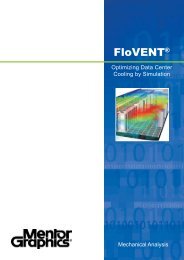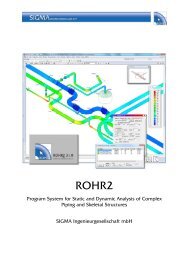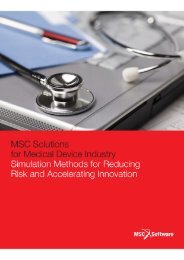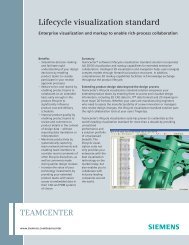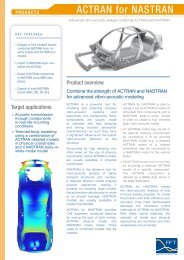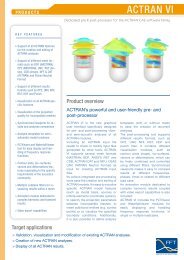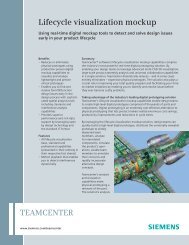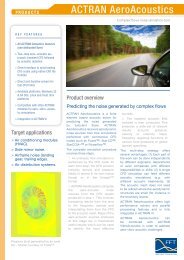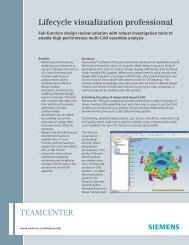Create successful ePaper yourself
Turn your PDF publications into a flip-book with our unique Google optimized e-Paper software.
MSC <strong>Fatigue</strong> ® Fracture<br />
Crack Growth Analysis<br />
MSC <strong>Fatigue</strong> ® Fracture uses stress results from finite element (FE) models, variations<br />
in loading & cyclic material properties to estimate crack propagation rates & times.<br />
Traditional linear elastic fracture mechanics (LEFM) are used to determine<br />
crack growth.<br />
Crack Growth Modeling<br />
MSC <strong>Fatigue</strong> ® Fracture provides<br />
sophisticated crack growth modeling for<br />
estimating life to grow a crack through a<br />
structure. Features include:<br />
• Kitagawa minimum crack sizing<br />
• Fracture toughness failure criterion<br />
• Mean stress correction<br />
• Rain flow cycle counting with<br />
cycle re-ordering<br />
• Initial and final crack length specifications<br />
• Plane stress correction<br />
• Notch effects modeling<br />
• Retardation and closure effects modeling<br />
• Modified Paris law modeling based on<br />
effective stress intensity range<br />
• User-defined life units<br />
• Fracture mechanics triangle solutions<br />
(stress – stress intensity – crack length)<br />
• Graphical interface to NASA/FLAGRO<br />
2.03 (via Patran or MSC <strong>Fatigue</strong> ® Pre &<br />
Post)<br />
• Stress tensor combination/resolution<br />
Models and results can be imported in a<br />
variety of ways: Patran neutral and external<br />
(nod, ele, els) results file MSC Nastran OP2<br />
and XDB file Marc ® , ABAQUS, ANSYS and<br />
SDRC results files<br />
14 | MSC Software<br />
Fracture analysis is performed using stress<br />
results from FE models that define the<br />
nominal or far field stress, which can be<br />
defined as a single location or averaged<br />
from an area on the model. Manual input<br />
is also possible with no reliance on an FE<br />
model. Results access features include FE<br />
results data from:<br />
• Patran database (linear static and<br />
transient results)<br />
• MSC Nastran , ANSYS, ABAQUS, Marc ® ,<br />
and any other Patran supported analysis<br />
code<br />
Multiple FE load cases with associated<br />
time variations can be defined and applied<br />
simultaneously. A time history database is<br />
supplied to facilitate creation and storage of<br />
these files.<br />
A materials database manager stores and<br />
manipulates a library of cyclic material<br />
properties. Features include:<br />
• Approximately 200 materials (metals)<br />
supplied<br />
• Add, create, or modify your own or<br />
supplied materials data (Imperial & SI<br />
units supported)<br />
Graphical display of:<br />
• Apparent stress intensity (DK)<br />
• Effective stress intensity (DK)<br />
• Threshold ratio DK plots<br />
Possible Results<br />
• Interactive XY plot of crack growth during<br />
the analysis<br />
• Final crack length versus life curve<br />
• Final crack growth rate curve<br />
• Life interpolation due to different initial<br />
and final crack sizes<br />
• Stress history output<br />
• Tabular listing of life:<br />
- crack size,<br />
- growth rate<br />
- stress range<br />
- Apparent DK<br />
- Effective DK<br />
- Current overload K<br />
- Residual K<br />
- K at crack closure<br />
- K from static fracture<br />
- Effective stress ratio<br />
• Sensitivity studies of:<br />
- Multiple initial crack sizes<br />
- Multiple final crack sizes<br />
- Cyclic material parameters<br />
- Mean stress<br />
- Crack type<br />
- Environment






